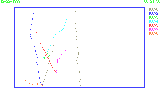

The Mode 115 is shipped from the factory with the desired customer setup saved in EEPROM, where it persists through battery changes. The drifter can be operated using a magnet applied to two marked areas of the drifter hull. A "beep code" audible through the case allows personnel without a computer to monitor and confirm proper drifter operation before deployments. If desired, an internal RS-232 interface port allows the end user to alter the operational setup and save the changes to EEPROM.
 Click for sample graphics screen from real time tracking software. Click for sample graphics screen from real time tracking software. |
Decoding and tracking software is included with all GPS/Argos drifters at no charge:
|
Brightwaters Instrument Corporation has been building autonomous drifting buoys since 1991, with the current Model 115 representing a sixth generation of design. Innovations developed at Brightwaters have been adopted across the drifter industry. Continuous design improvements reflect Brightwaters' commitment to offer the most technically advanced drifters in the world.
| Brightwaters products page |  |
Contact Brightwaters |  |
Brightwaters home page |